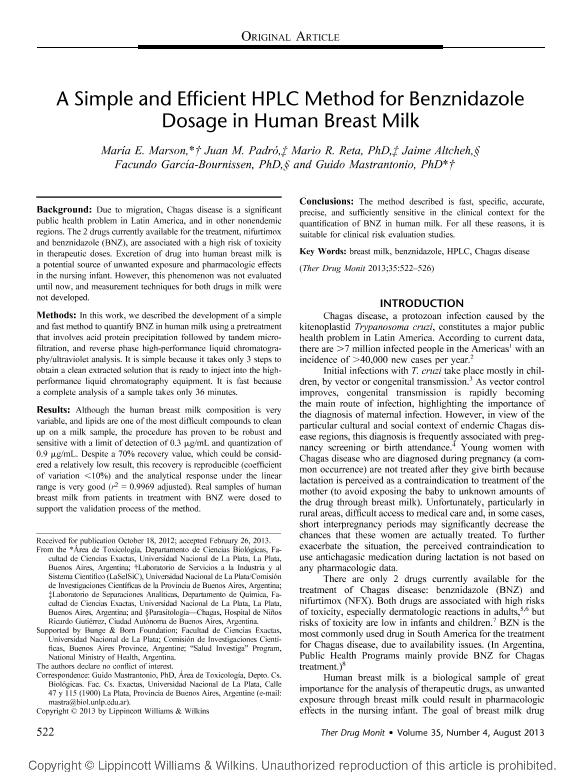Artículo
A simple and efficient HPLC method for benznidazole dosage in human breast milk
Marson, María Elena ; Padró, Juan Manuel
; Padró, Juan Manuel ; Reta, Mario Roberto
; Reta, Mario Roberto ; Altcheh, Jaime Marcelo
; Altcheh, Jaime Marcelo ; García Bournissen, Facundo
; García Bournissen, Facundo ; Mastrantonio Garrido, Guido Enrique
; Mastrantonio Garrido, Guido Enrique
 ; Padró, Juan Manuel
; Padró, Juan Manuel ; Reta, Mario Roberto
; Reta, Mario Roberto ; Altcheh, Jaime Marcelo
; Altcheh, Jaime Marcelo ; García Bournissen, Facundo
; García Bournissen, Facundo ; Mastrantonio Garrido, Guido Enrique
; Mastrantonio Garrido, Guido Enrique
Fecha de publicación:
08/2013
Editorial:
Lippincott Williams
Revista:
Therapeutic Drug Monitoring
ISSN:
0163-4356
Idioma:
Inglés
Tipo de recurso:
Artículo publicado
Clasificación temática:
Resumen
BACKGROUND: Due to migration, Chagas disease is a significant public health problem in Latin America, and in other nonendemic regions. The 2 drugs currently available for the treatment, nifurtimox and benznidazole (BNZ), are associated with a high risk of toxicity in therapeutic doses. Excretion of drug into human breast milk is a potential source of unwanted exposure and pharmacologic effects in the nursing infant. However, this phenomenon was not evaluated until now, and measurement techniques for both drugs in milk were not developed. METHODS: In this work, we described the development of a simple and fast method to quantify BNZ in human milk using a pretreatment that involves acid protein precipitation followed by tandem microfiltration, and reverse phase high-performance liquid chromatography/ultraviolet analysis. It is simple because it takes only 3 steps to obtain a clean extracted solution that is ready to inject into the high-performance liquid chromatography equipment. It is fast because a complete analysis of a sample takes only 36 minutes. RESULTS: Although the human breast milk composition is very variable, and lipids are one of the most difficult compounds to clean up on a milk sample, the procedure has proven to be robust and sensitive with a limit of detection of 0.3 μg/mL and quantization of 0.9 μg/mL. Despite a 70% recovery value, which could be considered a relatively low result, this recovery is reproducible (coefficient of variation <10%) and the analytical response under the linear range is very good (r = 0.9969 adjusted). Real samples of human breast milk from patients in treatment with BNZ were dosed to support the validation process of the method. CONCLUSIONS: The method described is fast, specific, accurate, precise, and sufficiently sensitive in the clinical context for the quantification of BNZ in human milk. For all these reasons, it is suitable for clinical risk evaluation studies.
Palabras clave:
Breast Milk
,
Benznidazole
,
Hplc
,
Chagas Disease
Archivos asociados
Licencia
Identificadores
Colecciones
Articulos(CCT - LA PLATA)
Articulos de CTRO.CIENTIFICO TECNOL.CONICET - LA PLATA
Articulos de CTRO.CIENTIFICO TECNOL.CONICET - LA PLATA
Articulos(SEDE CENTRAL)
Articulos de SEDE CENTRAL
Articulos de SEDE CENTRAL
Citación
Marson, María Elena; Padró, Juan Manuel; Reta, Mario Roberto; Altcheh, Jaime Marcelo; García Bournissen, Facundo; et al.; A simple and efficient HPLC method for benznidazole dosage in human breast milk; Lippincott Williams; Therapeutic Drug Monitoring; 35; 4; 8-2013; 522-526
Compartir
Altmétricas



